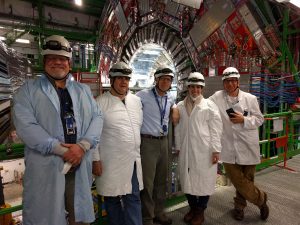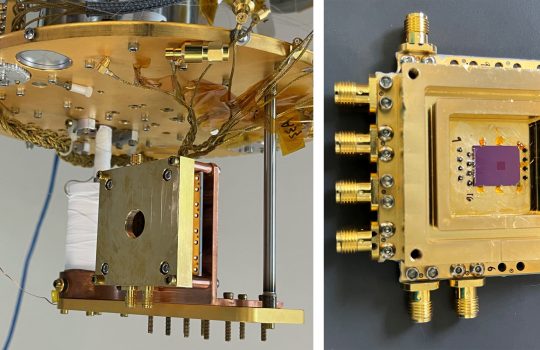Sometimes big questions require big tools. That’s why a global community of scientists designed and built gigantic detectors to monitor the high-energy particle collisions generated by CERN’s Large Hadron Collider in Geneva, Switzerland. From these collisions, scientists can retrace the footsteps of the Big Bang and search for new properties of nature.
The CMS experiment is one such detector. In 2012, it co-discovered the elusive Higgs boson with its sister experiment, ATLAS. Now, CMS scientists want to push beyond the known laws of physics and search for new phenomena that could help answer fundamental questions about our universe. But to do this, the CMS detector needed an upgrade.
“Just like any other electronic device, over time parts of our detector wear down,” said Steve Nahn, a researcher in the U.S. Department of Energy’s Fermilab and the U.S. project manager for the CMS detector upgrades. “We’ve been planning and designing this upgrade since shortly after our experiment first started collecting data in 2010.”
A completed forward pixel disk is installed in its service cylinder, where it will eventually be connected to electronics and cooling. Each of the 672 silicon sensors is connected to electronics boards via thin flexible cables (seen dangling below the disk). The map (seen on the table) is important for routing all the cables and making the right connections inside the service cylinder.
From left: Stephanie Timpone, Greg Derylo, Otto Alvarez, all of Fermilab. Photo: Maximilien Brice, CERN
The CMS detector is built like a giant onion. It contains layers of instruments that track the trajectory, energy and momentum of particles produced in the LHC’s collisions. The vast majority of the sensors in the massive detector are packed into its center, within what is called the pixel detector. The CMS pixel detector uses sensors like those inside digital cameras but with a lightning fast shutter speed: In three dimensions, they take 40 million pictures every second.
For the last several years, scientists and engineers at Fermilab and 21 U.S. universities have been assembling and testing a new pixel detector to replace the current one as part of the CMS upgrade, with funding provided by the Department of Energy Office of Science and National Science Foundation.
The pixel detector consists of three sections: the innermost barrel section and two end caps called the forward pixel detectors. The tiered and can-like structure gives scientists a near-complete sphere of coverage around the collision point. Because the three pixel detectors fit on the beam pipe like three bulky bracelets, engineers designed each component as two half-moons, which latch together to form a ring around the beam pipe during the insertion process.
This shows the outermost section of the forward pixel detector. Each green wedge is a pixel module. “Pixel modules are complex electronic sandwiches,” Marco Verzocchi said. The silicon sensor is in the middle, the readout chips are on the bottom, and the green printed circuit is on top. The 66,650 pixels and 16 readout chips per module are all interconnected through delicate wiring and electronics.
The flexible copper cables emanating from the pixel modules bring the data collected by the silicon sensors to the readout electronics (which are hidden behind the yellow covers.) The silvery object in the middle of the photograph is the beam pipe with its support wire below. Photo: Satoshi Hasegawa, Fermilab
Over time, scientists have increased the rate of particle collisions at the LHC. In 2016 alone, the LHC produced about as many collisions as it had in the three years of its first run. To be able to differentiate between dozens of simultaneous collisions, CMS needed a brand new pixel detector.
The upgrade packs even more sensors into the heart of the CMS detector. It’s as if CMS graduated from a 66-megapixel camera to a 124-megapixel camera.
Each of the two forward pixel detectors is a mosaic of 672 silicon sensors, robust electronics and bundles of cables and optical fibers that feed electricity and instructions in and carry raw data out, according to Marco Verzocchi, a Fermilab researcher on the CMS experiment.
The multipart, 6.5-meter-long pixel detector is as delicate as raw spaghetti. Installing the new components into a gap the size of a manhole required more than just finesse. It required months of planning and extreme coordination.
“We practiced this installation on mock-ups of our detector many times,” said Greg Derylo, an engineer at Fermilab. “By the time we got to the actual installation, we knew exactly how we needed to slide this new component into the heart of CMS.”
The CMS detector is currently open so that scientists can install the pixel detector into the very center of the experiment (around the beam pipe). A crane lowered the six pieces of the pixel detector through a 100-meter-deep pit onto the CMS cavern. A second crane then placed it on the yellow platform which was set up specially for this installation. Photo: Maximilien Brice, CERN
The most difficult part was maneuvering the delicate components around the pre-existing structures inside the CMS experiment.
“In total, the full three-part pixel detector consists of six separate segments, which fit together like a three-dimensional cylindrical puzzle around the beam pipe,” said Stephanie Timpone, a Fermilab engineer. “Inserting the pieces in the right positions and right order without touching any of the pre-existing supports and protections was a well-choreographed dance.”

Fermilab members of the CMS collaboration traveled to CERN to help install the pixel detector into the CMS detector. From left: Greg Derylo, Marco Verzocchi, Steve Nahn, Stephanie Timpone, Stefan Gruenendahl. Photo: Max Chertok, University of California, Davis
For engineers like Timpone and Derylo, installing the pixel detector was the last step of a six-year process. But for the scientists working on the CMS experiment, it was just the beginning.
“Now we have to make it work,” said Stefanos Leontsinis, a postdoctoral researcher at the University of Colorado, Boulder. “We’ll spend the next several weeks testing the components and preparing for the LHC restart.”
View a photo gallery of the pixel detector installation in symmetry magazine.



